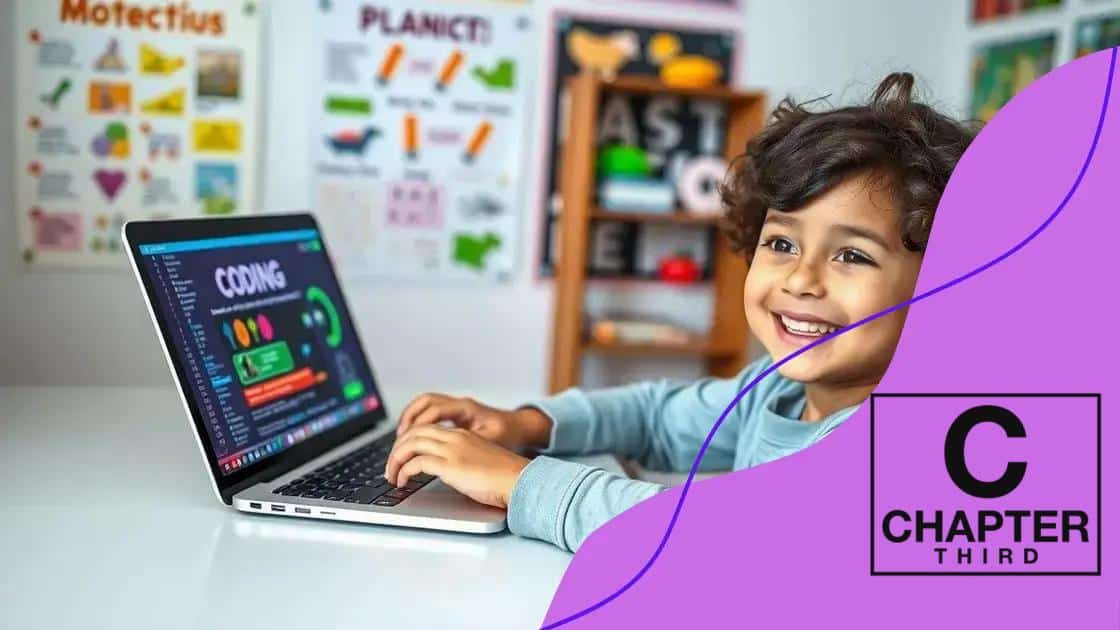Gamified coding courses for kids: fun learning at home

Gamified coding courses for kids offer an engaging way to learn programming by incorporating game elements that boost motivation, creativity, and critical thinking skills, making coding accessible and fun.
Gamified coding courses for kids make learning programming exciting and interactive. Have you ever thought about how your child could benefit from coding while having fun? In this article, we’ll explore how these courses are reshaping educational experiences.
Benefits of gamified coding courses
Gamified coding courses offer numerous advantages that can transform the way kids learn programming. These courses not only make learning fun but also foster a deeper understanding of coding skills and concepts.
Engaging Learning Experience
One of the primary benefits is that gamified coding courses create an engaging learning environment. By incorporating game-like elements, these courses motivate kids to participate actively in their education. Instead of a traditional classroom setup, children are immersed in interactive challenges where they can explore and play. This excitement fuels their desire to learn.
Development of Critical Thinking
Gamified learning also enhances critical thinking skills. As kids progress through levels and solve coding puzzles, they must think critically about how to tackle each challenge. This experience encourages creativity and problem-solving abilities, which are essential in any programming task.
Social interaction and collaboration
Many gamified coding courses encourage social interaction among peers. Kids can work together, share ideas, and collaborate on projects. This collaboration not only makes learning more enjoyable but also teaches important teamwork skills. Collaboration fosters a sense of community, which is crucial for young learners.
Instant Feedback
Another significant benefit is the instant feedback provided by gamified platforms. Children receive immediate results on their coding efforts, allowing them to learn from their mistakes right away. This rapid feedback loop helps to reinforce learning and build confidence. They easily understand what works well and what needs improvement, which accelerates their learning curve.
- Enhanced engagement through fun gameplay
- Promotion of critical thinking and creativity
- Opportunities for social collaboration
- Immediate feedback to boost learning
Ultimately, gamified coding courses can lead to improved academic performance as children become more motivated learners. As they develop a passion for programming, they are more likely to pursue tech-related subjects in the future. By making coding accessible and enjoyable, these courses pave the way for kids to build essential skills in a rapidly evolving digital world.
How gamification enhances learning
Gamification plays a crucial role in enhancing learning, especially in coding courses for kids. By incorporating game elements, learning becomes exciting. This approach increases motivation and makes children more likely to engage with the material.
Increased Motivation
When children are rewarded for their progress in a game-like environment, it creates a sense of achievement. This increased motivation drives them to complete challenges and continue learning. Kids love to earn points, badges, or other rewards, which keeps them invested in their education.
Improved Retention
Gamification also aids in information retention. Kids are more likely to remember what they learn through interactive experiences than through traditional methods. Engaging storytelling within the coding courses helps contextualize the material, making it easier to grasp challenging concepts.
Development of a Growth Mindset
In a gamified setting, failures are viewed as opportunities to learn rather than setbacks. This approach nurtures a growth mindset. Children are encouraged to attempt challenges repeatedly, helping them understand that perseverance is vital for success.
- Gamification boosts motivation through rewards
- Interactive learning improves material retention
- Encourages a growth mindset by embracing challenges
- Fosters collaboration and teamwork among peers
Additionally, gamified courses encourage critical thinking. As kids solve puzzles or navigate through levels, they must think creatively and strategically. This enhances their problem-solving skills, which are essential in coding and beyond. By integrating gamification into learning, we create an environment that nurtures curiosity and involvement.
Age-appropriate coding games

When selecting coding games for children, age-appropriate options are essential. These games not only cater to the child’s developmental stage but also ensure they remain engaged. Choosing the right games can enhance learning outcomes by making coding fun and accessible.
Preschool and Early Elementary (Ages 4-7)
For younger children, simple coding games that use visual blocks are a great start. These games allow kids to drag and drop commands to create sequences. This setup helps them develop problem-solving skills without the need for complex syntax.
- Examples: ScratchJr, Code.org’s games
- Focus on basic concepts like sequencing and loops
- Encourages creativity through storytelling
At this age, it’s important to keep the learning environment playful. Children learn best through play, so incorporating fun characters and colorful visuals will help maintain their interest.
Late Elementary (Ages 8-12)
As children grow, they can handle more challenging coding games. These games often introduce text-based coding while still keeping the interactive elements. This age group benefits from games that promote logical thinking and allow for more complex problem-solving.
- Examples: Code Combat, Tynker
- Focus on basic programming languages like Python or JavaScript
- Encourages collaboration through multiplayer options
At this stage, kids are ready to understand the basics of coding languages and can start creating their own projects. The motivation to learn increases if they can see their creations in action.
Middle School and Above (Ages 13+)
For teens, coding games can be more focused on real-world application. These games often resemble actual coding syntax and may even touch on advanced topics. They can tackle serious coding projects that build on their foundational knowledge.
- Examples: GitHub Learning Lab, Roblox Studio
- Focus on web development, game design, or app creation
- Encourages independent learning and exploration
At this age, inspiring students to innovate becomes crucial. They’ll appreciate games that allow them to express their creativity and challenge their skills. This preparation is vital as they may consider careers in technology.
Overall, selecting age-appropriate coding games helps children develop valuable skills at the right pace. By aligning games with their maturity level and interests, we can foster a love for coding early on.
Top platforms for coding courses
Choosing the right platform for coding courses is vital for kids’ learning. The best platforms offer interactive features that engage young learners while teaching valuable skills. Here are some top options that stand out for providing excellent coding education.
Scratch
Scratch is a fantastic starting point for kids, especially younger ones. This platform allows children to learn programming concepts through visual blocks. It promotes creativity by letting them create animations, games, and stories. Scratch is free and has a supportive community where kids can share their creations and get feedback.
Code.org
Code.org is another excellent resource for teaching coding to kids. It offers various courses designed for different age groups, making it easy to find the right fit. The platform features engaging games and activities that teach fundamental programming skills while keeping students entertained.
- Interactive coding exercises
- Courses for all age levels
- Support from educators
Code.org uses popular characters and themes from well-known films to attract learners. This keeps kids motivated and excited about coding.
Tynker
Tynker offers a comprehensive learning experience for kids. This platform uses gamification to teach coding concepts, making learning fun and interactive. Tynker provides various courses that range from beginner to advanced levels, helping kids progress as they build their skills.
- Wide range of courses and themes
- Interactive coding challenges and projects
- Options for self-paced learning
Kids can create their own games and apps while navigating through different learning paths. Tynker also offers resources for schools, allowing teachers to incorporate coding into their curriculum seamlessly.
Codecademy
For older children and teenagers, Codecademy provides more advanced coding courses. This platform focuses on text-based coding languages such as Python, Java, and HTML/CSS. Codecademy offers an interactive environment where users receive instant feedback on their code.
- Real-world coding languages
- Integration of projects to apply knowledge
- Community forums for support
The hands-on approach helps build confidence and prepares students for future coding challenges. Exploring these platforms can provide kids the opportunity to discover their passion for coding and technology, whether they’re looking to create video games or build websites. By using the top coding course platforms, learners can develop essential skills for their future.
Tips for parents on supporting learners
Parents play a vital role in supporting their children as they engage with coding courses. Knowing how to encourage kids can make a significant difference in their learning journey. Here are some effective tips to help parents provide the right support.
Encourage Curiosity
One of the best ways to support learners is by encouraging their natural curiosity. Ask your child questions about what they are learning. Show interest in their projects and celebrate their achievements, no matter how small. This positive reinforcement will motivate them to explore new topics in coding.
Create a Comfortable Learning Environment
A conducive learning environment is essential for kids to focus. Set up a quiet, organized space with minimal distractions. Ensure that your child has access to the necessary resources, such as a computer or tablet and a stable internet connection. A consistent routine can also help them stay on track with their coding practice.
Engage with Coding Together
Learning coding together can be a fun bonding experience. You don’t need to be an expert; simply sharing the experience makes it more enjoyable. Work on projects together or explore coding games as a team. This approach not only strengthens your relationship but also allows you to understand the challenges they face.
- Join in on coding activities
- Help them troubleshoot problems
- Encourage them to explain what they’ve learned
By engaging with them, you create an open dialogue where they feel free to ask questions and share ideas.
Limit Screen Time Wisely
While promoting coding, it’s important to manage screen time effectively. Encourage breaks and balance between coding and other activities. Discuss the importance of physical activities and social interactions outside of technology. This balance helps nurture well-rounded development and prevents burnout.
Provide Resources and Opportunities
Help your child discover additional learning resources. This could include books, educational websites, or local coding clubs. Look for coding competitions or events that they can participate in. Real-world applications of their skills can inspire and motivate them.
- Explore online coding courses
- Attend local coding workshops
- Find coding clubs or group activities
Supporting your child as they learn coding is a rewarding experience. By following these tips, parents ensure that their children enjoy exploring coding while developing essential skills. The right encouragement and resources can foster a love for technology that lasts a lifetime.
FAQ – Frequently Asked Questions about Gamified Coding Courses for Kids
What are gamified coding courses?
Gamified coding courses are educational programs that use game-like elements to make learning programming fun and engaging for children.
How can parents support their child in coding?
Parents can support their child by creating a comfortable learning environment, encouraging curiosity, and engaging with coding activities together.
What age group is suitable for gamified coding courses?
Gamified coding courses are suitable for various age groups, from preschool children to teens, with content tailored to each developmental stage.
What skills do children develop through coding courses?
Children develop problem-solving skills, logical thinking, creativity, and teamwork through gamified coding courses.






